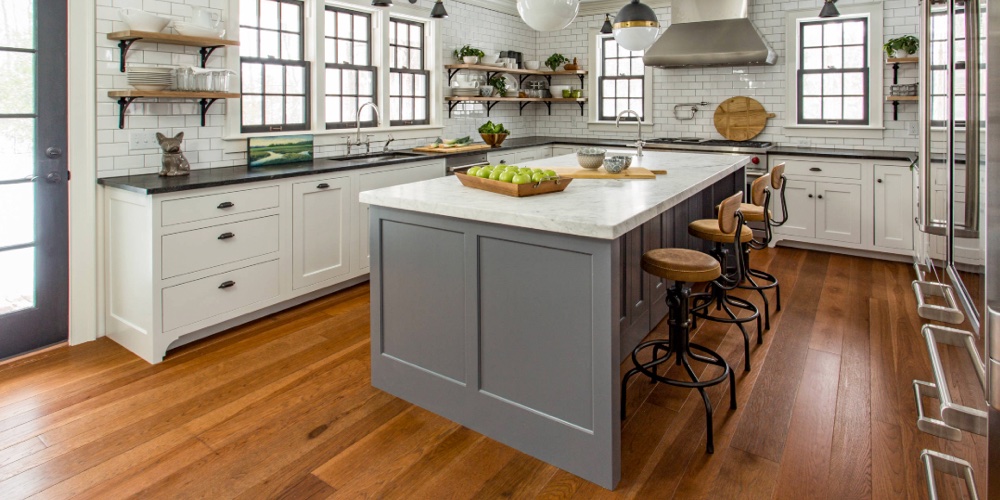The 4 Best Flooring Materials For Your Home
Carpet, Linoleum, Stone, or Wood?

Carpet, linoleum, stone, or wood. Eeny, meeny, miny, moe. When it comes to choosing your flooring, you might feel compelled to rely on that universal childhood rhyme given the competing pros and cons of each material compounded by the long-term ramifications of the decision. But before you throw up your hands, let’s dig into the options and leave catching the tiger by the toe for a less momentous assessment.
The first step is to develop your criteria. Is cost most critical? What about a product’s durability and lifespan? How much do you value comfort underfoot? How important is sustainability or a healthy living environment? What about aesthetics and beauty? Are you hoping to install it yourself, or hire that out to a professional? Different people will put different weight on each of these factors, so there is no one-size-fits-all “best” option.
Carpeting
Sixty to seventy percent of homes in the United States have some form of carpeting. The reason for this ubiquity is likely a combination of its relatively inexpensive cost, general ease of installation, and comfort underfoot. Carpets average $2 to $7 per square foot, depending on the materials used (synthetic vs. natural) and the pile (the density of fiber used). Installation labor adds $0.50 to $1 per square foot. Though installation is fairly inexpensive, it does require a bit of know-how and the proper tools, so it is best left to an experienced installer.
Carpeting’s fibrous quality can feel good to shoeless feet and can invite you to use your floors in different ways, especially for households with kids. Crawling, game playing, and even napping are all options with a cushioned floor beneath you. But that pile can have a drawback, namely it is prone to collect and hold pollen, dust, dust mites, and pet dander, all of which potentially cause allergic reactions.
Additionally, carpets with synthetic fibers are most often backed by petroleum-based products, including latex, PVC, or polyurethane. And many carpets are additionally treated with chemicals to repel stains and retard fire or mildew. All together, it’s an unhealthy, or even toxic, stew that can off-gas volatile organic compounds (VOCs). And carpeting has a relatively short lifespan, which negates its relatively low price point by necessitating replacement.
Linoleum and Vinyl
Linoleum and its more contemporary sibling, vinyl, are all about value. Costs range from $1 to $5 per square foot, depending on whether you are buying tiles or sheets. Linoleum typically will fall on the higher end of that spectrum, and vinyl on the lower. For installation, expect to pay $3 to $5 per square foot for sheet goods, and between $5 and $7 per square foot for tiles, with linoleum again landing on the higher end of these ranges. Installation can be a DIY affair for someone who is handy and has the right tools, which can cut down on the costs. Tiles are easier to install than sheets, which require precise cutting to fit irregular spaces.
Linoleum and vinyl offer some clear positive attributes in addition to their affordability. They both possess a relatively soft feel. They come in a wide variety of colors and patterns to fit virtually any aesthetic. And they are generally maintenance free, beyond sweeping and mopping.
On the downside, vinyl is a petroleum-based product made of PVC and other chemicals. As a result, it can off-gas after installation and is generally not considered very eco-friendly. (Linoleum, which is produced with primarily renewable materials, including linseed oil and pine rosin, and is biodegradable, scores much higher on the sustainability scale.) Additionally, both materials can scratch or gauge easily due to their “soft” nature, and they can show their age if not maintained.
Stone and Ceramic
Tile and stone have been used for millennia as flooring materials. They offer impeccable beauty and unmatched durability. They are also considered to be relatively sustainable, as they are quarried or derived from natural, earth-based materials, though this is offset somewhat by their weight, which requires a lot of energy expenditure for transportation. They also have a long lifespan, resulting in fewer items in the landfill over time. And, regarding health in the home, stone and tile are easy to clean and have a very low potential for harboring allergens.
Different types of stone tiles have different propensities regarding absorption and traction, which can affect where in your house they are appropriate. Stone with a high level of imperviousness would be better suited to high-traffic areas that may get wet, such as entry rooms and kitchens. And stone with a low coefficient of friction is not well suited for bathrooms, where it can get quite slippery with the addition of a little water. Stone and tile require maintenance – they need to be sealed and re-sealed periodically to protect them.
Ceramic and porcelain tiles are generally less pricey than stone, running between $3 and $6 per square foot for ceramic, and $5–$8 for porcelain, which is harder and more durable than ceramic. Expect to pay $6–$10 for natural stone. Installation for all stone and tiles is time consuming, though not complicated, and can be done by anyone who is somewhat handy (and who has access to a tile saw). For professional installation, expect to pay between $6 and $12 a square foot, depending on the type and size of the tiles, the type of subfloor, and the complexity of the room configuration.
Wood Products
Wood has been used as a flooring material for hundreds of years and is currently the most common choice for homeowners. Much of this has to do with its natural beauty and durability. Wood adds a luxurious warmth to virtually any home, and it never goes out of style. It has a lengthy lifespan, and many wood products can be sanded and refinished, bringing them back to their original luster. Another factor compelling wood’s popularity is the burgeoning number of wood-related product options, including engineered flooring, laminates, cork, and bamboo, in addition to traditional hardwoods of various species.
Wood flooring is widely considered an eco-friendly choice. It is a renewable resource, generally requires minimal processing, is long-lasting, and is biodegradable when its lifespan is over. There are variables within this context, however. Laminates require an energy-intensive production process, for instance, and hardwoods can be harvested regionally and sustainably, or can be clear-cut unsustainably from the Amazon rainforest. And while bamboo and cork are highly renewable, they are energy-intensive to grow, and must be shipped from Asia and North Africa.
Though wood flooring is durable, it is not impenetrable. Different species and products offer varying levels of hardness, but they can all be dented, scratched, and scuffed to varying degrees. And wood and water are not a good combination, though cork is naturally water-resistant, and engineered lumber, which is comprised of layers of plywood topped by a veneer of solid hardwood, provides greater structural stability in the face of moisture and wetness than do most other wood flooring products.
Wood flooring varies in cost, with laminates on the lower end at $1 to $6 a square foot. Additionally, they are easy to install as a DIY project. Cork and bamboo cost approximately $4 to $7 per square foot with an equal expenditure for installation. Custom-milled solid hardwood flooring and engineered flooring cost between $6 to $20+ dollars per square foot depending on the species, grade, width, plank structure, and other specs. As for installation, expect $3 to $8 per square foot, depending on whether the planks are prefinished or need to be finished on-site, and the width of your planks.
Conclusions
Although many people may focus on cost as a deciding factor, keep in mind that cost upfront doesn’t take into consideration costs down the road. A product that needs continual expensive upkeep or that will need to be replaced in five or 10 years is likely not your most cost-effective option. Additionally, some products, such as stone or wood, may actually add value to your home, offsetting some or all of the cost. And most importantly, consider your aesthetic inclination and your lifestyle. Choose the flooring that will give you the most pleasure as you look at and walk on it each and every day.







